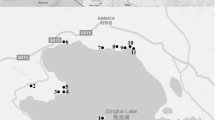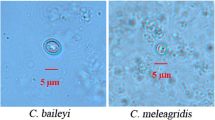Abstract
Cryptosporidium is an important intestinal zoonotic pathogen that can infect various hosts and cause diarrheal disease. There are no reports on the prevalence and molecular characterization of Cryptosporidium in wild birds in Cyprus. Therefore, the present study aimed to determine the prevalence of Cryptosporidium spp. and genotypes in wild birds found at Phassouri Reedbeds (Akrotiri Wetlands), Cyprus. Fecal samples of 75 wild birds (Eurasian coot Fulica atra, N = 48; Eurasian teal Anas crecca, N = 20; duck – Anas spp., Ν = 7) were screened for Cryptosporidium by PCR amplification and sequencing. Only one sample (1.3%) belonging to a Eurasian coot was PCR-positive for Cryptosporidium. Based on sequencing of the 18S rRNA locus, this species was identified as Cryptosporidium proventriculi. This is the first report on the molecular identification of this Cryptosporidium species in a Eurasian coot.

Similar content being viewed by others
Data availability
The material obtained in this study is stored at the Laboratory of Health Sciences Faculty of the Nicosia University. Representative nucleotide sequences obtained in this study were submitted to the GenBank® under the accession number: OM870407.
References
Amer S, Wang C, He H (2010) First detection of Cryptosporidium baileyi in ruddy shelduck (Tadorna ferruginea) in China. J Vet Med Sci 72:935–938. https://doi.org/10.1292/jvms.09-0515
Batz MB, Hoffmann S, Morris JG (2012) Ranking the disease burden of 14 pathogens in food sources in the United States using attribution data from outbreak investigations and expert elicitation. J Food Prot 75:1278–1291. https://doi.org/10.4315/0362-028X.JFP-11-418
Cano L, de Lucio A, Bailo B, Cardona G A, Muadica ASO, Lobo L, Carmena D. (2016). Identification and genotyping of Giardia spp. and Cryptosporidium spp. isolates in aquatic birds in the Salburua wetlands, Álava, Northern Spain. Vet Parasitol 221:144-8 https://doi.org/10.1016/j.vetpar.2016.03.026
Hellicar MA, Anastasi V, Beton D Snape R (2014). Important bird areas of Cyprus. Bird Life Cyprus, Nicosia, Cyprus
Holubová N, Sak B, Hlásková L, Květoňová D, Hanzal V, Rajský D, Rost M, McEvoy J, Kváč M (2018) Host specificity and age-dependent resistance to Cryptosporidium avium infection in chickens, ducks and pheasants. Exp Parasit 191:62–65. https://doi.org/10.1016/j.exppara.2018.06.007
Holubová N, Zikmundová V, Limpouchová Z, Sak B, Konečný R, Hlásková L, Rajský D, Kopacz Z, McEvoy J, Kváč M (2019) Cryptosporidium proventriculi sp. n. (Apicomplexa: Cryptosporidiidae) in Psittaciformes birds. Europ J Protistol 69:70–87. https://doi.org/10.1016/j.ejop.2019.03.001
Hoque S, Mavrides DE, Pinto P, Costa S, Begum N, Azevedo-Ribeiro C, Liapi M, Kváč M, Malas S, Gentekaki E, Tsaousis AD (2022) High occurrence of zoonotic subtypes of Cryptosporidium parvum in Cypriot dairy farms. Microorg 10:531
Jian Y, Zhang X, Li X, Schou C, Charalambidou I, Ma L, Karanis P (2021) Occurrence of Cryptosporidium and Giardia in wild birds from Qinghai Lake on the Qinghai-Tibetan Plateau, China. Parasitol Res 120: 615-628.https://doi.org/10.1007/s00436-020-06993-w
Karanis P (2018) The truth about in vitro culture of Cryptosporidium species. Parasitol 145:855–864. https://doi.org/10.1017/S0031182017001937
Koompapong K, Mori H, Thammasonthijarern N, PrasertbunR, Pintong A R, PoprukS, RojekittikhunW, Chaisiri K, Sukthana Y, Mahittikorn A (2014) Molecular identification of Cryptosporidium spp. in seagulls, pigeons, dogs, and cats in Thailand. Paras 21: 52. https://doi.org/10.1051/parasite/2014053
Kotloff KL (2017) The burden and etiology of diarrheal illness in developing countries. Ped Clinics North America 64:799–814. https://doi.org/10.1016/j.pcl.2017.03.006
Kuhn RC, Rock CM, Oshima KH (2002) Occurrence of Cryptosporidium and Giardia in wild ducks along the Rio Grande River valley in Southern New Mexico. Appl Environ Microbiol 68:161–165. https://doi.org/10.1128/AEM.68.1.161-165.2002
Liu J, Platts-Mills JA, Juma J, Kabir F, Nkeze J, Okoi C, Operario DJ, Uddin J, Ahmed S, Alonso PL, Antonio M, Becker SM, Blackwelder WC, Breiman RF, FaruqueAS G, Fields B, Gratz J, Haque R, Hossain A, … Houpt ER (2016) Use of quantitative molecular diagnostic methods to identify causes of diarrhoea in children: a reanalysis of the GEMS case-control study. Lancet 388: 1291-1301.https://doi.org/10.1016/S0140-6736(16)31529-X
Majewska AC, Graczyk TK, Słodkowicz-KowalskaA TL, Jędrzejewski S, Zduniak P, Solarczyk P, Nowosad A, Nowosad P (2009) The role of free-ranging, captive, and domestic birds of Western Poland in environmental contamination with Cryptosporidium parvum oocysts and Giardia lamblia cysts. Parasitol Res 104:1093–1099. https://doi.org/10.1007/s00436-008-1293-9
Nakamura AA, Meireles MV (2015) Cryptosporidium infections in birds - a review. Rev Bras Parasitol Vet 24:253–267. https://doi.org/10.1590/S1984-29612015063
Ng J, Pavlasek I, Ryan U (2006) Identification of novel Cryptosporidium genotypes from avian hosts. App Environ Microbiol 72:7548–7553. https://doi.org/10.1128/AEM.01352-06
Pavlásek I (1993) The black-headed gull (Larus ridibundus L.), a new host for Cryptosporidium baileyi (Apicomplexa: Cryptosporidiidae). Veterinární Medicína 38:629–638
Plutzer J, Tomor B (2009) The role of aquatic birds in the environmental dissemination of human pathogenic Giardia duodenalis cysts and Cryptosporidium oocysts in Hungary. Parasitol Internat 58:227–231
Ryan U, Hijjawi N (2015) New developments in Cryptosporidium research. Int J Parasitol 45:367–373. https://doi.org/10.1016/j.ijpara.2015.01.009
Ryan U, Zahedi A, PapariniA, (2016) Cryptosporidium in humans and animals—a one health approach to prophylaxis. Paras Immunol 38:535–547. https://doi.org/10.1111/pim.12350
Ryan U, Fayer R, Xiao L (2014) Cryptosporidium species in humans and animals: current understanding and research needs. Parasitol 141: 1667–1685
Salathé T (2002) Ramsar mission to Cyprus’ Akrotiri salt lake. Akrotiri Wetland Complex, UK Sovereign Base Area, Cyprus. Unpublished Mission Report, 17–21 June 2002.
Schou C, Hasapis KA, Karanis P (2022) Molecular identification of Cryptosporidium species from domestic ruminants and wild reptiles in Cyprus. Parasitol Res 121:2193–2198
Tsintides T, Christodoulou CS, Delipetrou P, Georgiou K (eds) (2007) The red data book of the flora of Cyprus. Cyprus Forestry Association, Nicosia, Cyprus.
Wang R, Jian F, Sun Y, Hu Q, Zhu J, Wang F, Ning C, Zhang L, Xiao L (2010) Large-scale survey of Cryptosporidium spp. in chickens and Pekin ducks (Anas platyrhynchos) in Henan, China: prevalence and molecular characterization. Avian Pathol 39:447–451
Zhou L, Kassa H, Tischler ML, Xiao L (2004) Host-adapted Cryptosporidium spp. in Canada geese (Branta canadensis). App Environ Microbiol 70:4211–4421
Zogaris S. (2017). Conservation study of the Mediterranean Killifish Aphanius fasciatus in Akrotiri Marsh, (Akrotiri SBA, Cyprus) - final report. Darwin Project DPLUS034 “Akrotiri Marsh Restoration: a flagship wetland in the Cyprus SBAs BirdLife Cyprus”. Nicosia Cyprus. Unpublished final report, 64 pp.
Acknowledgements
We are grateful to Katerina Georgiou for her assistance with collecting the samples.
Funding
This research received no external funding.
Author information
Authors and Affiliations
Contributions
All authors contributed to the study conception and design. Kyriacos A Hasapis, Eleni Tsouma, and Konstantina Sotiriadou: formal analysis and investigation, visualization, and writing—original draft. Nicolaos Kassinis: material collection. Chad Schou: material collection, formal investigation, and editing. Iris Charalambidou: conceptualization, methodology, writing—original draft, and supervision. Panagiotis Karanis: conceptualization, methodology, writing—review and editing, and overall supervision. The authors read and approved the final manuscript.
Corresponding author
Ethics declarations
Conflict of interest
The authors declare no competing interests.
Ethical approval
All applicable guidelines for the care or use of animals were followed.
Consent for publication
All authors agreed to the publication of the manuscript.
Additional information
Handling Editor: Una Ryan
Publisher's note
Springer Nature remains neutral with regard to jurisdictional claims in published maps and institutional affiliations.
Rights and permissions
Springer Nature or its licensor (e.g. a society or other partner) holds exclusive rights to this article under a publishing agreement with the author(s) or other rightsholder(s); author self-archiving of the accepted manuscript version of this article is solely governed by the terms of such publishing agreement and applicable law.
About this article
Cite this article
Hasapis, K.A., Charalambidou, I., Tsouma, E. et al. First detection of Cryptosporidium proventriculi from wild birds in Cyprus. Parasitol Res 122, 201–205 (2023). https://doi.org/10.1007/s00436-022-07717-y
Received:
Accepted:
Published:
Issue Date:
DOI: https://doi.org/10.1007/s00436-022-07717-y




